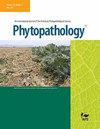Khee Man Kwon, Rick E Masonbrink, Thomas R Maier, Michael N Gardner, Andrew J Severin, Thomas J Baum, Melissa G Mitchum
求助PDF
{"title":"Comparative Transcriptomic Analysis of Soybean Cyst Nematode Inbred Populations Non-adapted or Adapted on Soybean <i>rhg1-a</i>/<i>Rhg4</i>-Mediated Resistance.","authors":"Khee Man Kwon, Rick E Masonbrink, Thomas R Maier, Michael N Gardner, Andrew J Severin, Thomas J Baum, Melissa G Mitchum","doi":"10.1094/PHYTO-03-24-0095-R","DOIUrl":null,"url":null,"abstract":"<p><p>Soybean cyst nematode (SCN, <i>Heterodera glycines</i>) is most effectively managed through planting resistant soybean cultivars, but the repeated use of the same resistance sources has led to a widespread emergence of virulent SCN populations that can overcome soybean resistance. Resistance to SCN HG type 0 (Race 3) in soybean cultivar Forrest is mediated by an epistatic interaction between the soybean resistance genes <i>rhg1-a</i> and <i>Rhg4</i>. We previously developed two SCN inbred populations by mass-selecting SCN HG type 0 (Race 3) on susceptible and resistant recombinant inbred lines, derived from a cross between Forrest and the SCN-susceptible cultivar Essex, which differ for <i>Rhg4</i>. To identify SCN genes potentially involved in overcoming <i>rhg1-a</i>/<i>Rhg4</i>-mediated resistance, we conducted RNA sequencing on early parasitic juveniles of these two SCN inbred populations infecting their respective hosts, only to discover a handful of differentially expressed genes (DEGs). However, in a comparison with early parasitic juveniles of an avirulent SCN inbred population infecting a resistant host, we discovered 59 and 171 DEGs uniquely up- or downregulated in virulent parasitic juveniles adapted on the resistant host. Interestingly, the proteins coded by these 59 DEGs included vitamin B-associated proteins (reduced folate carrier, biotin synthase, and thiamine transporter) and nematode effectors known to play roles in plant defense suppression, suggesting that virulent SCN may exert a heightened transcriptional response to cope with enhanced plant defenses and an altered nutritional status of a resistant soybean host. [Formula: see text] Copyright © 2024 The Author(s). This is an open access article distributed under the CC BY-NC-ND 4.0 International license.</p>","PeriodicalId":20410,"journal":{"name":"Phytopathology","volume":" ","pages":"2341-2350"},"PeriodicalIF":3.1000,"publicationDate":"2024-10-01","publicationTypes":"Journal Article","fieldsOfStudy":null,"isOpenAccess":false,"openAccessPdf":"","citationCount":"0","resultStr":null,"platform":"Semanticscholar","paperid":null,"PeriodicalName":"Phytopathology","FirstCategoryId":"97","ListUrlMain":"https://doi.org/10.1094/PHYTO-03-24-0095-R","RegionNum":2,"RegionCategory":"农林科学","ArticlePicture":[],"TitleCN":null,"AbstractTextCN":null,"PMCID":null,"EPubDate":"2024/10/4 0:00:00","PubModel":"Epub","JCR":"Q2","JCRName":"PLANT SCIENCES","Score":null,"Total":0}
引用次数: 0
引用
批量引用
Abstract
Soybean cyst nematode (SCN, Heterodera glycines ) is most effectively managed through planting resistant soybean cultivars, but the repeated use of the same resistance sources has led to a widespread emergence of virulent SCN populations that can overcome soybean resistance. Resistance to SCN HG type 0 (Race 3) in soybean cultivar Forrest is mediated by an epistatic interaction between the soybean resistance genes rhg1-a and Rhg4 . We previously developed two SCN inbred populations by mass-selecting SCN HG type 0 (Race 3) on susceptible and resistant recombinant inbred lines, derived from a cross between Forrest and the SCN-susceptible cultivar Essex, which differ for Rhg4 . To identify SCN genes potentially involved in overcoming rhg1-a /Rhg4 -mediated resistance, we conducted RNA sequencing on early parasitic juveniles of these two SCN inbred populations infecting their respective hosts, only to discover a handful of differentially expressed genes (DEGs). However, in a comparison with early parasitic juveniles of an avirulent SCN inbred population infecting a resistant host, we discovered 59 and 171 DEGs uniquely up- or downregulated in virulent parasitic juveniles adapted on the resistant host. Interestingly, the proteins coded by these 59 DEGs included vitamin B-associated proteins (reduced folate carrier, biotin synthase, and thiamine transporter) and nematode effectors known to play roles in plant defense suppression, suggesting that virulent SCN may exert a heightened transcriptional response to cope with enhanced plant defenses and an altered nutritional status of a resistant soybean host. [Formula: see text] Copyright © 2024 The Author(s). This is an open access article distributed under the CC BY-NC-ND 4.0 International license.
不适应或适应大豆 rhg1-a/Rhg4 介导的抗性的大豆胞囊线虫近交系种群的转录组比较分析。
大豆胞囊线虫(SCN,Heterodera glycines)最有效的防治方法是种植抗性大豆栽培品种,但重复使用相同的抗性来源已导致能够克服大豆抗性的强毒力 SCN 种群的广泛出现。大豆栽培品种 Forrest 对 SCN HG 0 型(Race 3)的抗性是由大豆抗性基因 rhg1-a 和 Rhg4 之间的外显相互作用介导的。之前,我们通过在易感和抗性重组近交系上大量选择 SCN HG 0 型(Race 3),培育出了两个 SCN 近交系群体,这两个近交系分别来自福瑞斯特和 SCN 易感栽培品种 Essex 的杂交种,它们的 Rhg4 存在差异。为了确定可能参与克服 rhg1-a/Rhg4 介导的抗性的 SCN 基因,我们对感染各自宿主的这两个 SCN 近交种群的早期寄生幼虫进行了 RNA 测序,结果只发现了少数几个差异表达基因(DEG)。然而,在与感染抗性宿主的无毒 SCN 近交种群的早期寄生幼虫进行比较时,我们分别发现了 59 个和 171 个 DEGs,这些 DEGs 在适应抗性宿主的毒性寄生幼虫中具有独特的上调或下调。有趣的是,这 59 个 DEGs 编码的蛋白包括维生素 B 相关蛋白(还原叶酸载体、生物素合成酶和硫胺素转运体)和已知在植物防御抑制中发挥作用的线虫效应物,这表明毒力 SCN 可能会加强转录反应,以应对植物防御能力的增强和抗性大豆宿主营养状况的改变。
本文章由计算机程序翻译,如有差异,请以英文原文为准。

 求助内容:
求助内容: 应助结果提醒方式:
应助结果提醒方式:


